Ever tried bonding MDF pieces and wondered if wood glue’s your best ally? Dive in to dispel those MDF myths!
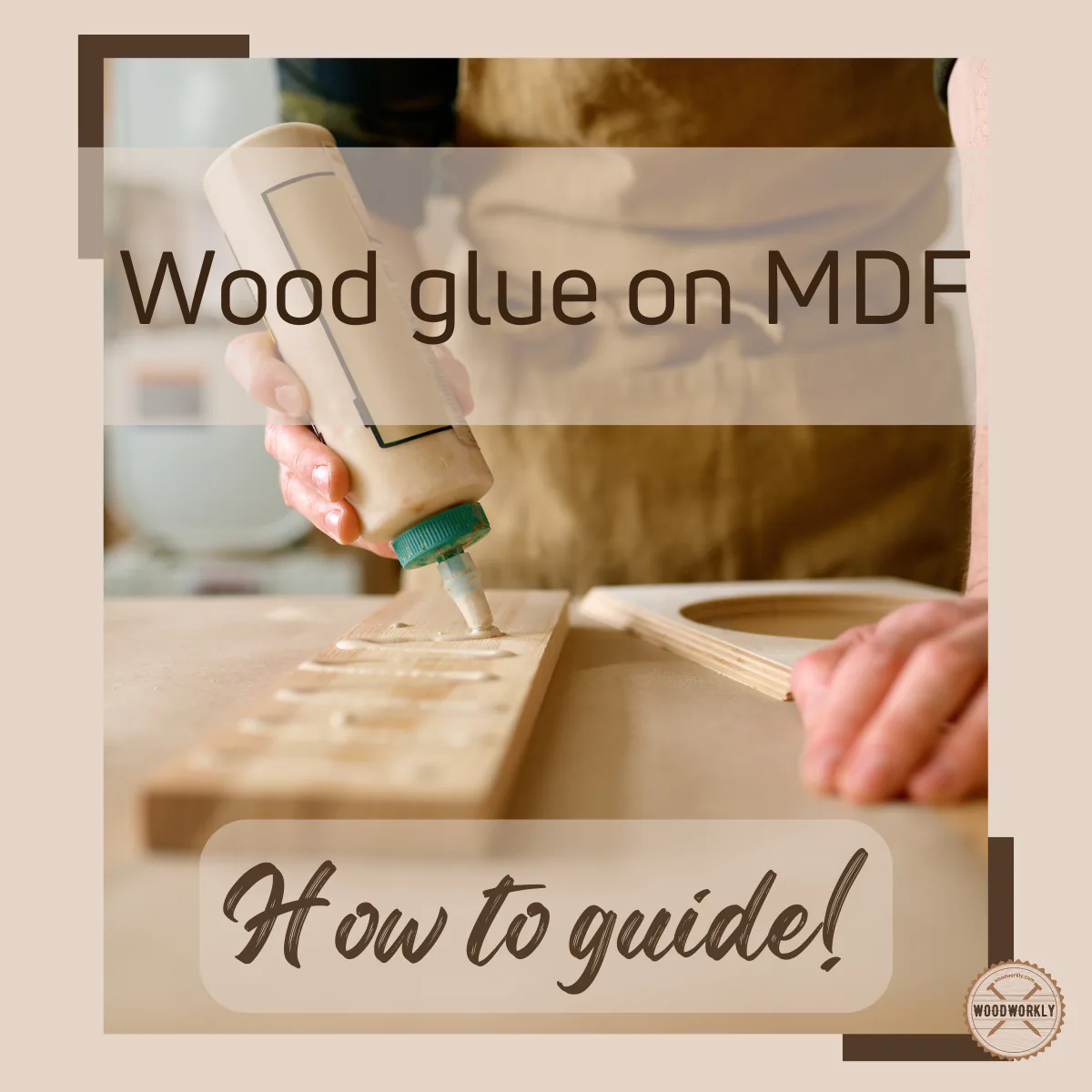
Ever wondered if wood glue sticks well to MDF as it does to our good old solid wood?
I had the same question, especially when I was about to make an MDF joint for a new dining table project.
So, I decided to chat with some woodworking pros to get the scoop. Here’s what I found out
So, let’s find out, Does Wood Glue Work on MDF?
Yes, wood glue works well on MDF. Particularly, PVA (Polyvinyl Acetate) wood glue offers a strong bond for MDF due to its porous nature. Ensure an even application to prevent swelling or warping, and use clamps for a secure connection.
But that’s just a quick snapshot of the question!

In this article, I’ll explore does wood glue work on MDF, best wood glue for MDF and how to use wood glue on MDF.
Furthermore, I’ll answer some frequently asked questions as well.
So, let’s keep going!
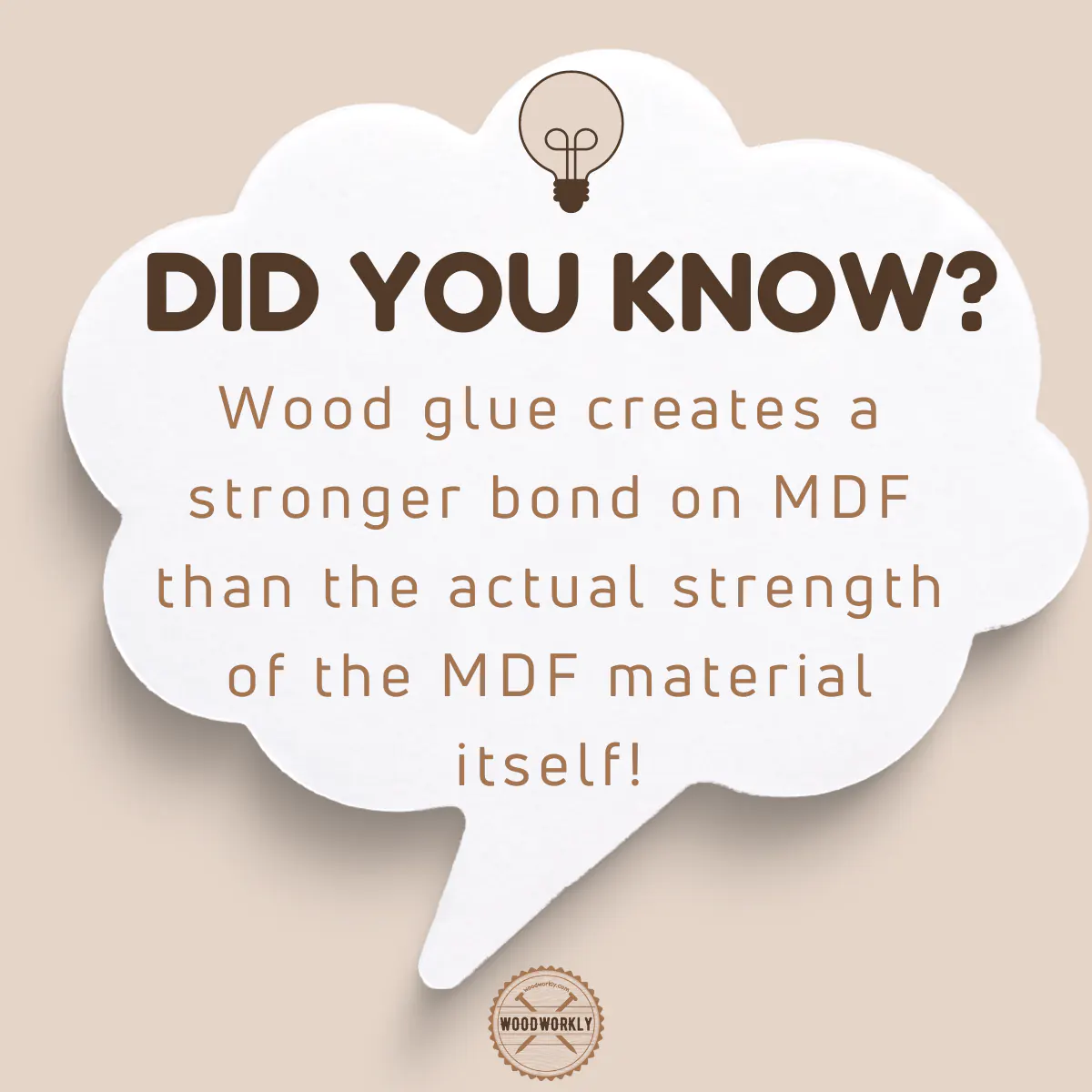
This post contains affiliate links. As an Amazon Associate, I earn from qualifying purchases. I endorse only products I truly recommend. If you make a purchase using one of these links, I may receive compensation at no extra cost to you. For more information, see my disclosure policies.
Can You Use Wood Glue On MDF?
Yes, you can use wood glue on MDF, but, it’s about the balance. The right glue, the right amount, and a little patience can make your MDF project stand the test of time.
You can apply wood glue over MDF but producing an MDF joint is more difficult than it seems. With good screws and suitable wood glues, you’ll be able to produce excellent joints.
Thanks to its unique composition, MDF has certain characteristics that make it both amenable and somewhat challenging when it comes to adhesion.
Let’s dive deep into the world of MDF and its bond with glues.
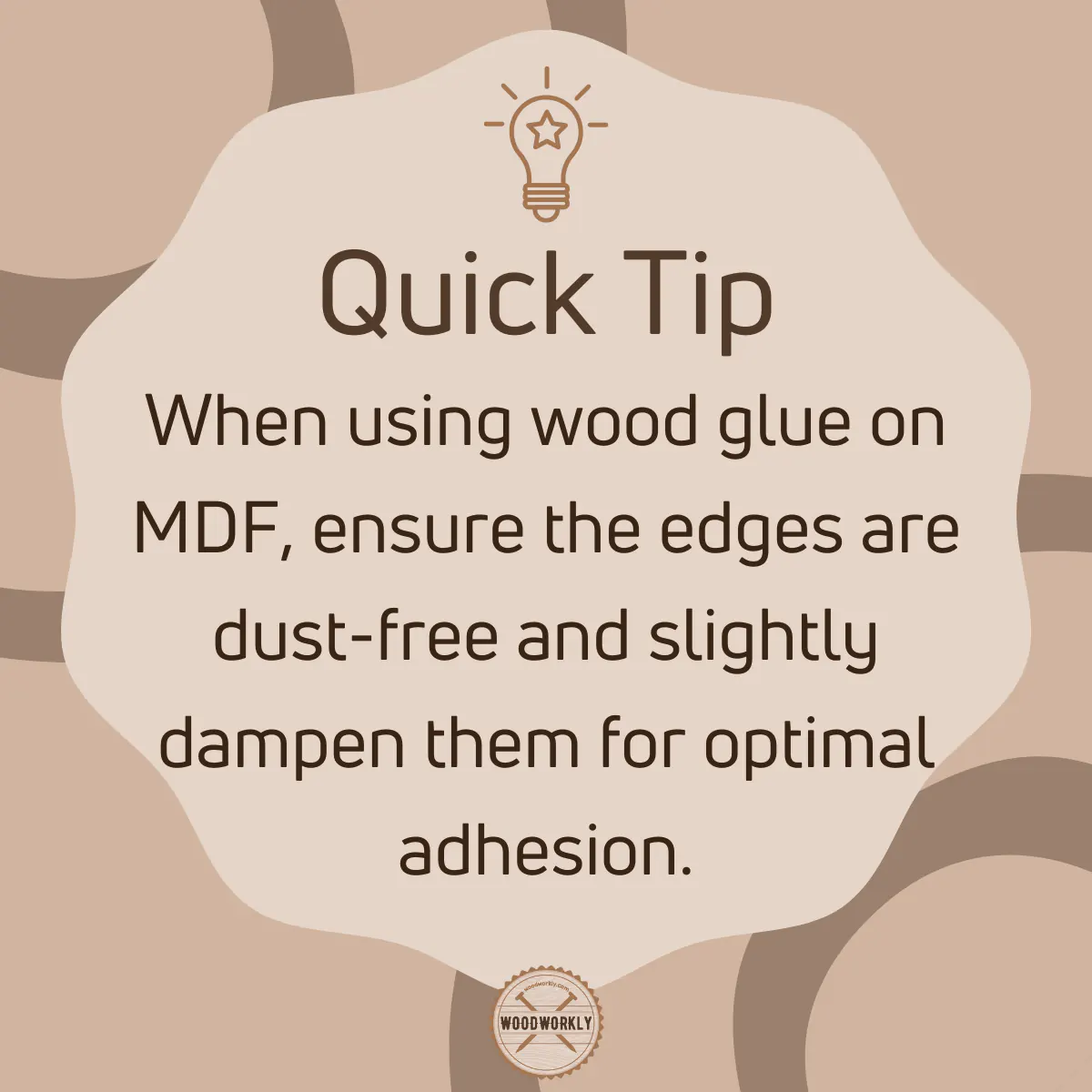
Understanding MDF
Firstly, let’s demystify what MDF is.
Born out of the combination of wood pieces and chips under the influence of hot hydraulic presses, MDF stands as a testimony to the innovation in the woodworking industry.
It’s lighter, affordable, and incredibly user-friendly, making it a darling of DIY enthusiasts and professional carpenters alike.
A Personal Touch: A few years ago, I was refurbishing my workspace.
Wanting to maintain a tight budget yet not compromising on quality, MDF was my go-to.
And guess what? The shelves I made back then? Still as sturdy as ever.
The Porosity Factor
One distinctive feature of MDF is its porosity. It’s more porous than many other types of wood.
This can be both a boon and a bane. On the one hand, the porous nature means the adhesive can seep in well, ensuring a strong bond.
On the other hand, too much glue, or the wrong type, and you risk damaging the MDF.
Story Time: Remember when I was talking about my workspace project? Well, here’s a little anecdote.
While working on one of the shelves, I got a bit over-enthusiastic and slathered on too much glue.
The result? The MDF board got a bit swollen in parts, reminding me of the importance of the ‘right amount’.
To Seal or Not to Seal
Before you even get to the gluing part, there’s a debate in the woodworking community about sealing MDF.
Some argue it’s unnecessary since MDF often doesn’t require a primer.
Others believe in the age-old wisdom of sealing it with a thin layer of resin or epoxy.
This step ensures the surface is even less susceptible to potential glue damage. It’s like wearing an extra layer on a particularly cold day, just in case!
Tip From Experience: If you’re working on a project where the finish is crucial, say a centerpiece coffee table or a decorative shelf, consider sealing the MDF.
It gives you that extra peace of mind. I did that for a coffee table project, and the finish was flawless.
Tips:
- Always make sure to apply more wood glue when working with MDF than you use for other solid wood types.
- When you’re selecting a wood glue for MDF go with the one that matches perfectly to your application.
- For example, In terms of exterior usage, you should go with whether proof of wood glue.
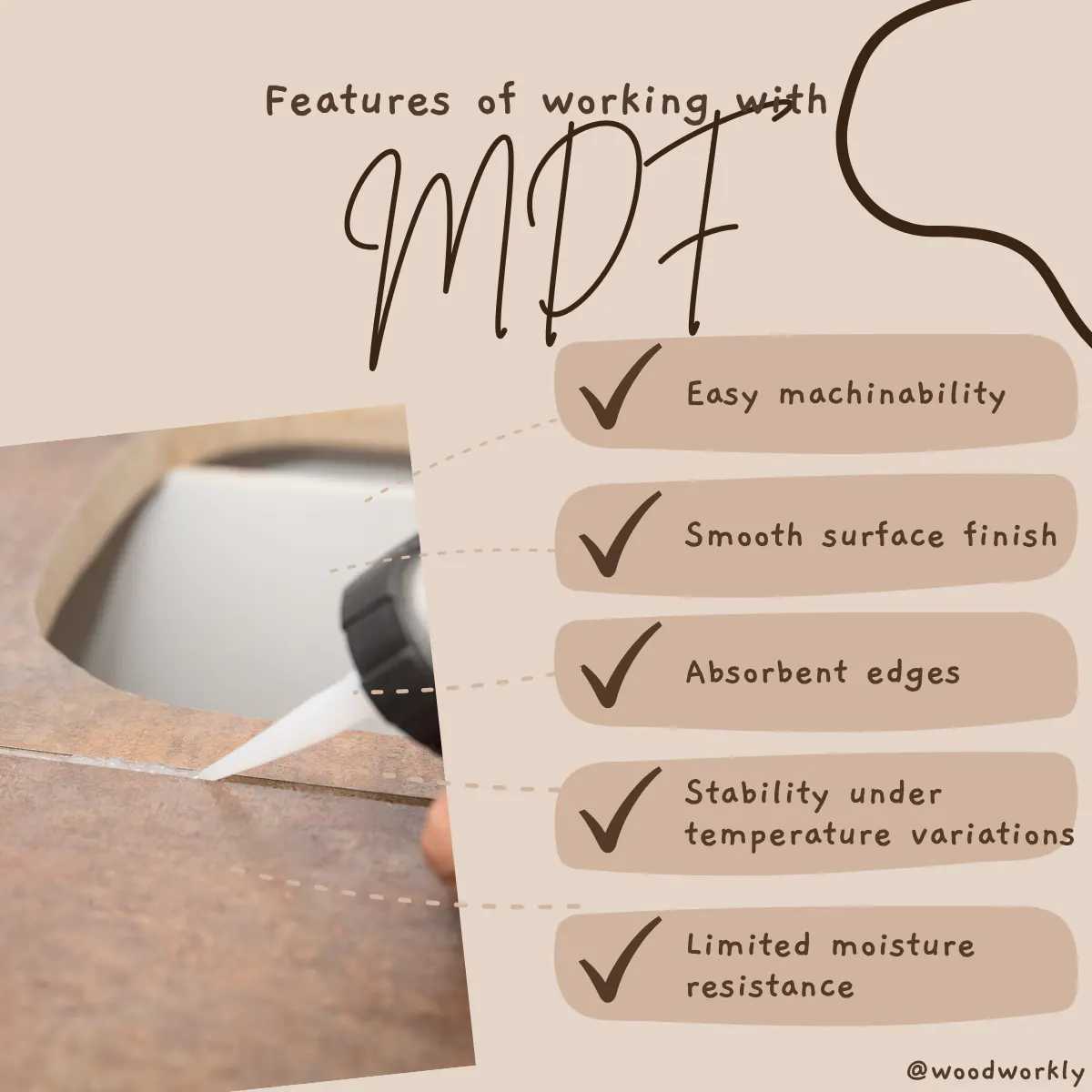
Best Wood Glue Types For MDF
If you’ve tinkered around with MDF, you know that the bond (pun intended) between the board and glue can make or break your project.
The quest for the perfect adhesive can feel a bit like a Goldilocks story – some might be too weak, others too strong, but a few are just right.
Lucky for you, I’ve been down this road before, and I’m here to guide you. Let’s dive into the best wood glue types for MDF.
There are main 3 types of wood glues use to stick MDF. They are,
- PVA (Polyvinyl Acetate) Wood Glue
- Plastic Resin Glue
- Epoxy Wood Glue
So, let’s talk about them in detail.
PVA (Polyvinyl Acetate) Wood Glue
PVA is known as the typical wood glue that we use for many woodworking projects. They work perfectly with solid woods and as well as MDF as well. PVA wood glue is made using PVA particles and water glues.
PVA wood glue is available in yellow and white varieties. PVA wood glues are great for both indoor and outdoor MDF applications.
Here’re some of the main qualities of PVA glue,
- Easy to find
- Affordable
- Quickly dry
- Curing time is 24 hours
- Versatility: PVA is water-based, which means it’s easy to clean, dries clear, and is non-toxic. A dream for DIYers!
- Bond Strength: For MDF, you want a bond that’s strong but not too aggressive. PVA provides just that, making it ideal for most MDF projects.
Yellow PVA wood glue is able to build a strong bond with MDF and dry easily than the white variant. Sanding is also easier with the yellow variant than the white one.
The biggest downgrade of PVA glue on MDF is no weather resistance. The water molecules can easily go inside the glue and make the bond weaker.
So, I recommend you use PVA glue on MDF only for Interior applications. They are not good for outdoor usage.
I recall crafting a bookshelf for my daughter’s room. The vibrant blue MDF boards I had picked were just begging for the perfect glue. Enter PVA.
It gave me enough working time, adhered beautifully, and has kept those shelves steady through countless storytimes.
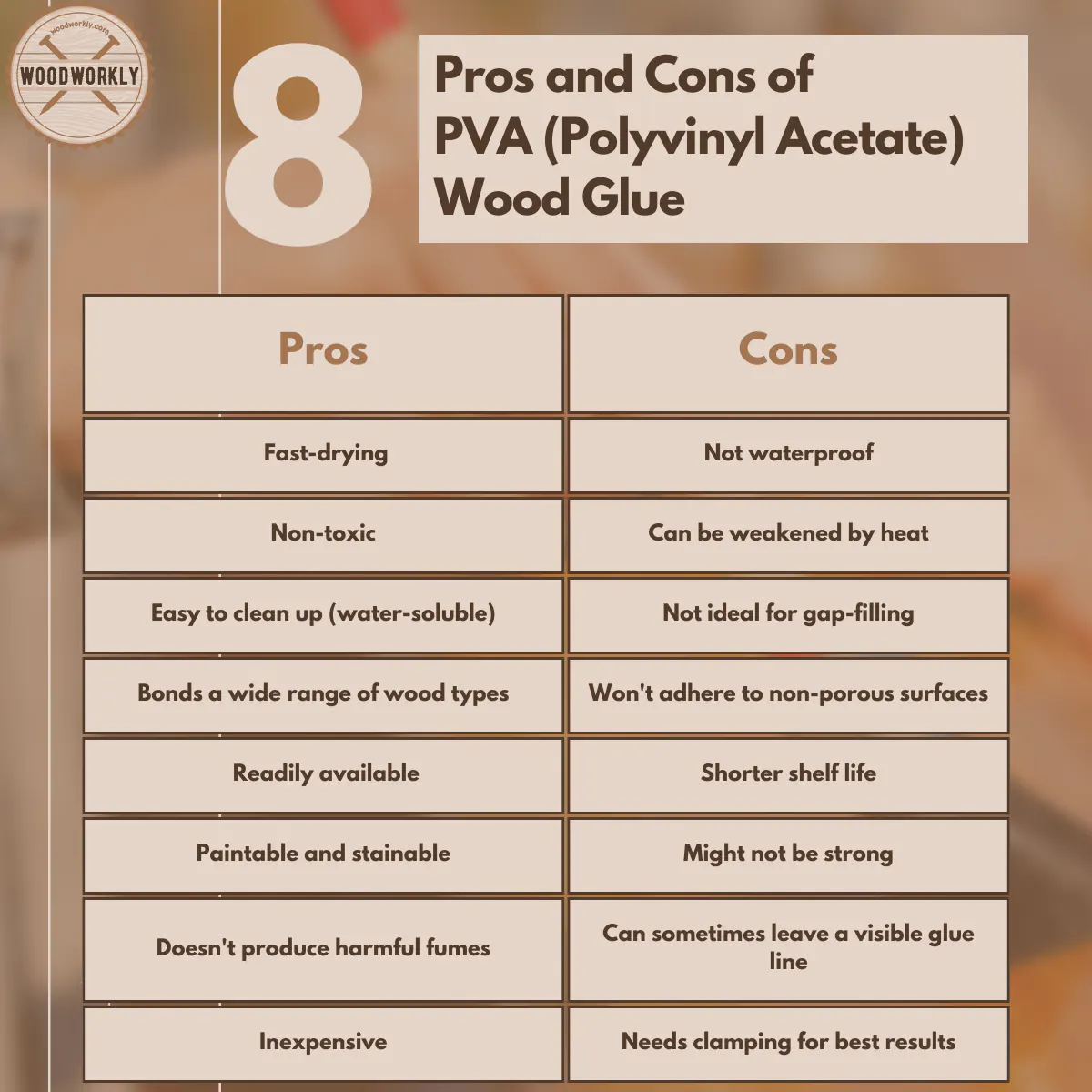
Plastic Resin Glue
This is the best alternative option you can go for MDF other than PVA glues. Plastic resin glue is recommended for outdoor applications.
Normally this wood glue is used for larger woodworking projects such as carpentry. This wood glue is made with urea-formaldehyde which is known as a highly toxic chemical.
There is a powder that comes with plastic resin wood glue you can match with the color you want.
Here’re the qualities of plastic resin glue,
- High durable
- Water Resistance: While not entirely waterproof, this glue offers a higher degree of water resistance than PVA.
- Heat Resistance: Got a project that might face some heat? This glue won’t lose its cool.
The drawbacks of this wood glue are,
- Highly toxic (Always wear protective gloves and goggles when using)
- Drying time is high
I don’t recommend plastic resin glue on MDF if you’re a beginner, because you need to be extremely careful due to its high toxicity.
When I was working on an outdoor MDF table, I decided to experiment with plastic resin glue.
The result? The table braved several summer BBQs, enduring both heat and occasional rain showers, all while holding its own!
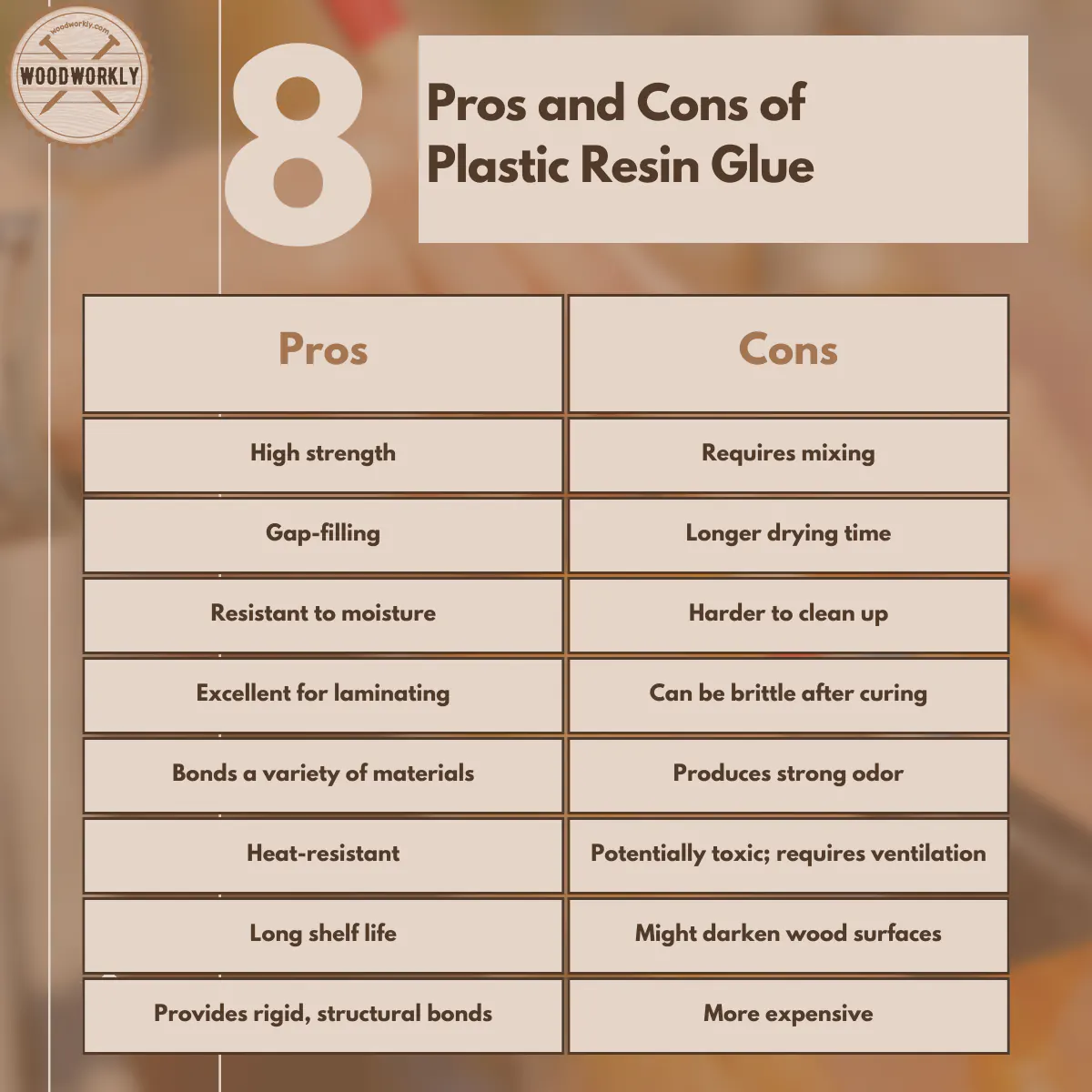
Epoxy Wood Glue
Epoxies are great to glue MDF surfaces, They come in different shapes and sizes. The drying time is approximately 24 hours.
Qualities of Epoxy wood glue are,
- Incredible Strength: Epoxy offers a bond that is arguably unbeatable.
- Filling Gaps: Working with imperfect MDF cuts? Epoxy can fill those minor gaps seamlessly.
The only downside of using epoxy is its expansiveness.
On renovating my kitchen, I had some MDF panels with slight imperfections. Instead of discarding them, I turned to epoxy.
Not only did it bond the panels effectively, but it also filled in the gaps, making everything look professionally done.

While these three glues are all excellent contenders, your project’s specific requirements will steer you towards the best fit.
Whether it’s the reliable PVA, the resilient plastic resin, or the robust epoxy, you have a stellar lineup to choose from.
What Is the Best Glue To Use On MDF?
Normally most of the wood glues work on MDF.
When it comes to the best glue to use on MDF, there are 5 commercial products I can highly recommend on MDF. They are,
- Titebond Ultimate wood glue
- Gorilla wood glue
- Elmer’s Carpenter’s wood glue
- Franklin International wood glue
- DAP 00157 Rapidfuse wood glue
Wood glue you need to select according to your MDF application type.
Some are good for the interior and some are for the exterior, some have good weather resistance, some are water-resistant only likewise.
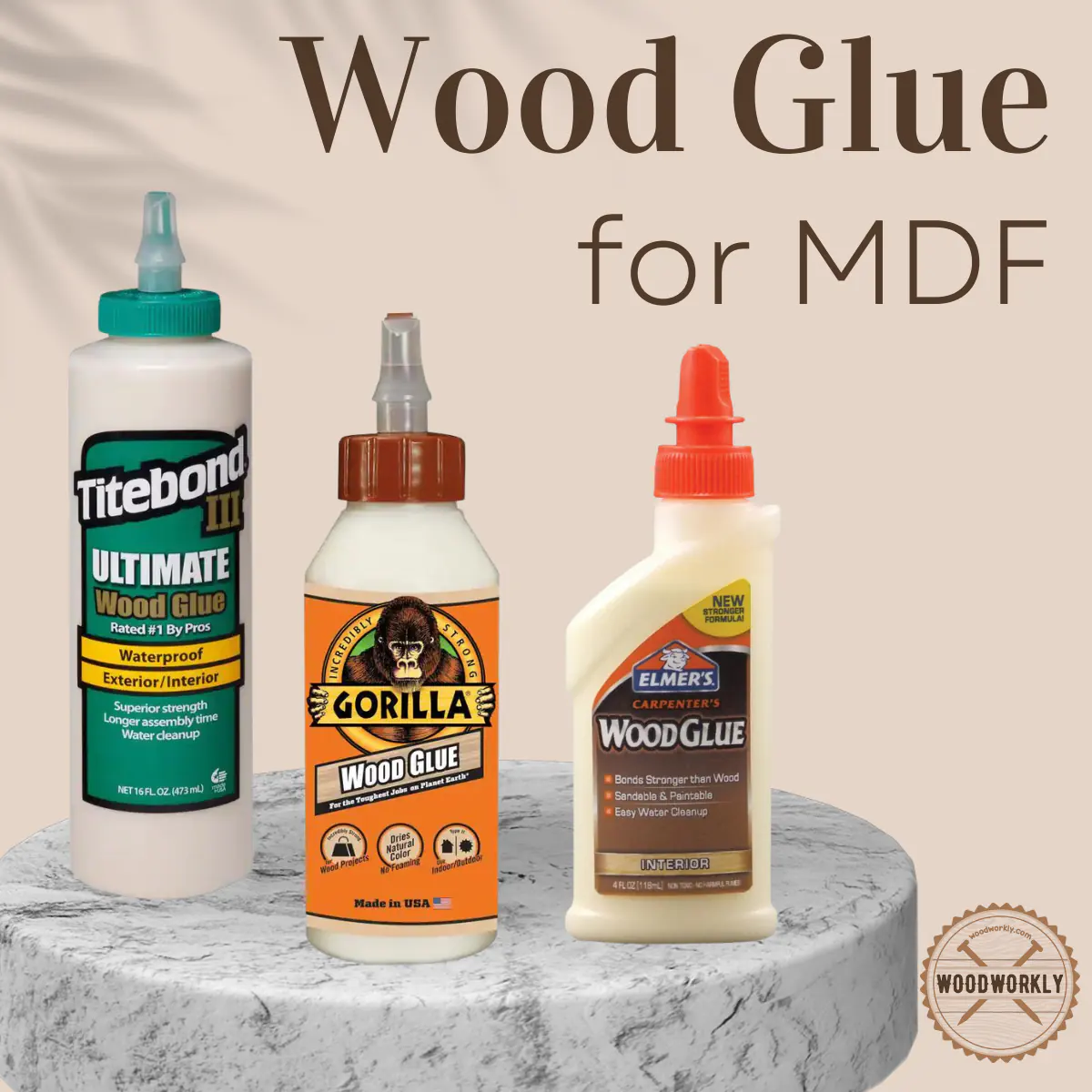
So, let’s dig into the top 3 wood glue products and discuss their application with the pros and cons of each for better understanding.
Tilebond Ultimate Wood Glue
Tilebond ultimate wood glue is known as the best wood glue for MDF.
It works perfectly for both interior and exterior applications by making a strong bond with MDF surfaces.
The advantages of Tilebond ultimate wood glue on MDF are as follows,
- It sets quickly
- Waterproof – great for interior and exterior applications
- Easy to clean with a damp cloth or water.
- Heat-resistant and easy to sand
- Nontoxic
- Provide strong bonding
- High durability
Cons of Tilebond ultimate wood glue over MDF are,
- A clamp holder is required until the glue is completely set
As you can see the productivity of Tilebond ultimate glue is high over many other commercial wood types of glue available on the market.
This wood glue is recommended for any type of MDF application.
Gorilla Wood Glue
Gorilla wood glue is a great choice for MDF projects especially if you’re a beginner.
Here’re some of the main advantages you’ll get from Gorilla wood glue,
- Easy to clean
- Build a strong bond
- Easy to use
- Excellent for interior and exterior applications
- Clamping time is low
- Water-resistant
- Able to apply on painted wood
Here’re some of the drawbacks of using gorilla wood glue on MDF,
- Thinner than other wood glues
- Curing time is high (24 hours)
Apart from having those ignorable cons, gorilla wood glue is excellent for any MDF woodworking project.
Check out, How to Remove Gorilla Glue from Wood? (EASY Guide!)
Elmer’s Carpenter’s Wood Glue
Elmer’s Carpenter’s wood glue is waterproof and stainable. It bonds stronger than other woods.
Also, it’s rich with the following qualities.
- Easy to use
- Easy to clean
- Valuable for money
- Waterproof
- Nontoxic
- Excellent for interior and exterior usage
- No odor
- Able to apply on stained wood
Apart from having the above qualities, Elmer’s Carpenter’s wood glue is,
- Thickness is a bit higher than other glues
- Curing time is high (24 hours)
That’s it. The above 3 products are considered the best wood glue on MDF for any interior or exterior application, bathroom, exterior columns, or kitchen maintenance.
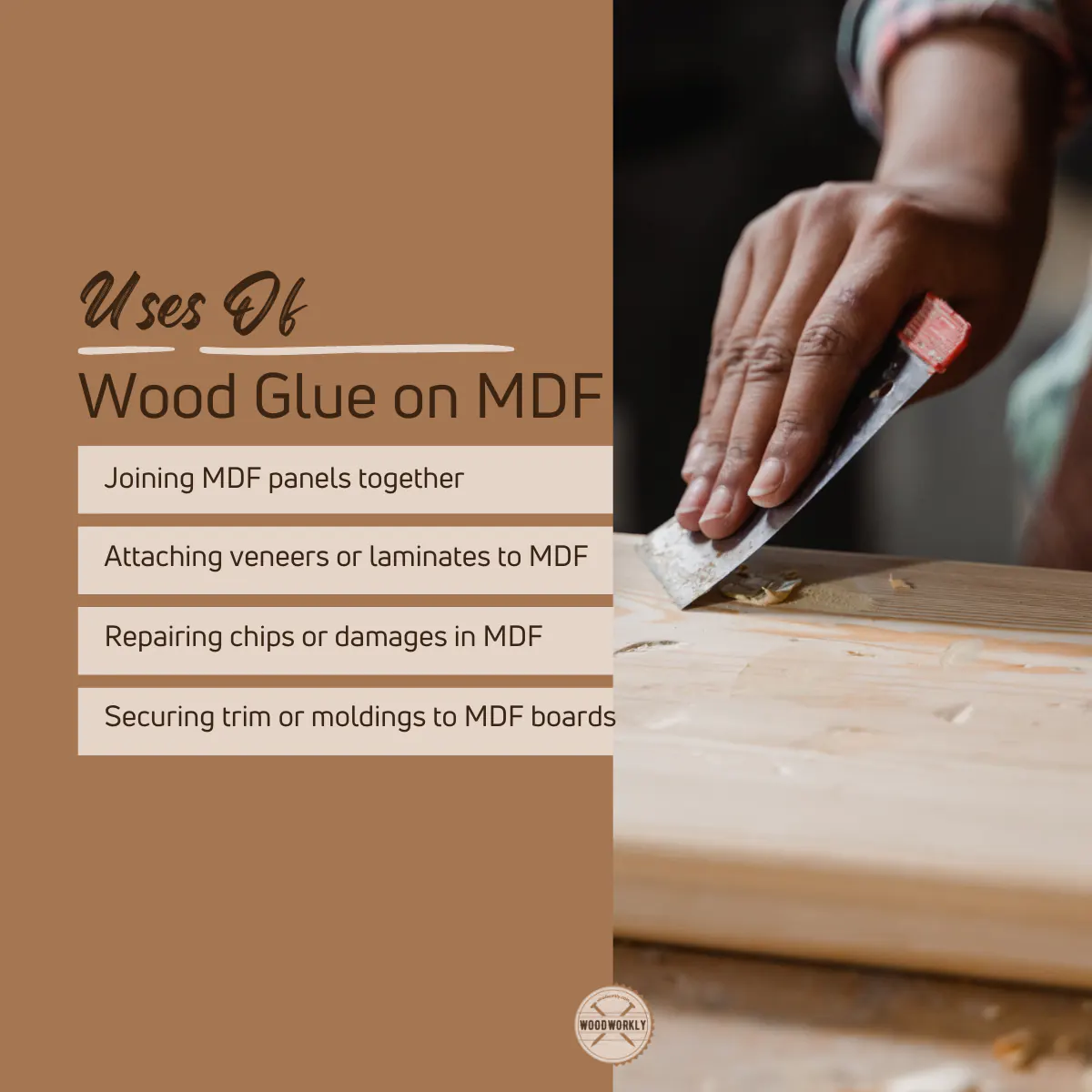
How To Glue MDF Together?
After you buy the most suitable wood glue for MDF according to your application, the next challenging task is to follow the procedure and apply glue on the MDF board.
Here’re the steps you need to follow when gluing MDF together,
- Surface Preparation
- Choose the right glue
- Apply a thick wood glue coat on the MDF board
- Clamp the MDF surface
- Use Glues and screws in edge joints
- Clean the surface
So, let’s discuss each of these steps in detail to use glue MDF efficiently.
1. Surface Preparation
Start Clean: Before diving headfirst into your project, make sure the surfaces of your MDF boards are clean and dust-free.
I’ve learned this the hard way. Once, while in a hurry, I tried gluing two dusty pieces.
The bond was weak, and let’s just say that shelf didn’t last long.
Sanding is Key: Give the MDF edges a light sanding with fine-grit sandpaper.
This not only cleans the surface but also gives the glue something to grip onto.
Just remember, it’s a bit like exfoliating your face – be gentle!
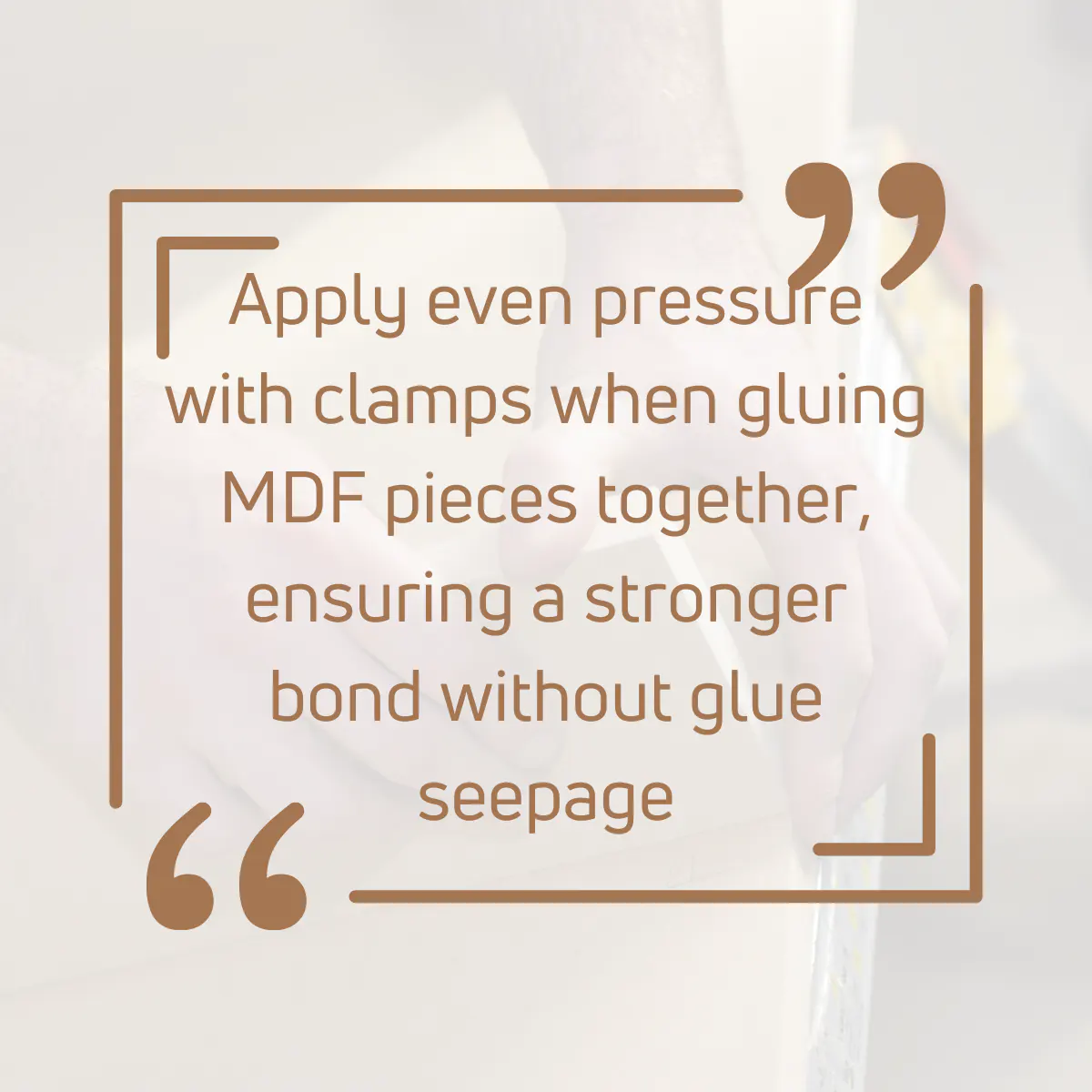
2. Choose the Right Glue
Having tested different types, I can say, without a doubt, that the glue matters.
While we’ve chatted about the best glues earlier, remember: the project’s purpose dictates the choice.
For my daughter’s indoor bookshelf, PVA was perfect.
But when I ventured to make an outdoor MDF table, I leaned towards plastic resin glue for its water resistance.
3. Apply Thick Wood Glue Coat On MDF Board
MDF is a porous wood. It’ll absorb the wood glue easily.
So, for better bonding, you need to apply a slightly higher amount of wood glue on top of the surface.
Thin and Even: Apply a thin, even layer of glue. Too much glue can make your MDF swell or warp, which no one wants!
I recall one enthusiastic afternoon where I slathered on glue like it was icing on a cake, only to have the MDF bulge. Lesson learned!
Spread it Out: Consider using a brush or a spatula to spread the glue. It ensures uniform coverage and prevents pooling in any one area.
Spread thick wood glue coating over MDF board uniformly. By doing that we can clearly ignore the amount absorbed into the MDF.
4. Clamp the MDF Surface
Clamps are your best friends when bonding MDF. Once you’ve applied your glue and aligned your boards, clamps will ensure a tight bond.
I remember a time when I underestimated the number of clamps I’d need for a large MDF project.
I ended up improvising with heavy books and even a kettlebell.
While it did the job, having the right clamps would have saved time and worry.
5. Use Glues and Screws in Edge Joints
MDF bonds are not sturdy like many other wood bonds.
So, there are occasions you need to use screws. I highly recommend you to use screws, especially in corner joints to get a strong bonding.
Always pick the screw size according to the size of your MDF board. Otherwise, you’ll end up splitting the MDF board easily.
6. Clean the Surface
Don’t forget to clean the surface after the job is done.
Allow the glue to dry completely based on the manufacturer’s recommendations.
Some glues set quickly, but for a strong bond, it’s best to let them cure for the suggested time.
I’ve been guilty of being impatient and moving my project too soon.
While it looked fine initially, over time, the bond weakened. Trust me, waiting a little longer is worth the strength and durability you’ll get.
Excess glue on the surface can ruin your work. Slight sanding is recommended to do this task perfectly.
Bonding MDF might sound tricky, but with the right steps, you’re on your way to a masterpiece.
Whether it’s a simple shelf, a swanky new desk, or an ambitious cabinet project, always remember: good prep and patience go a long way.
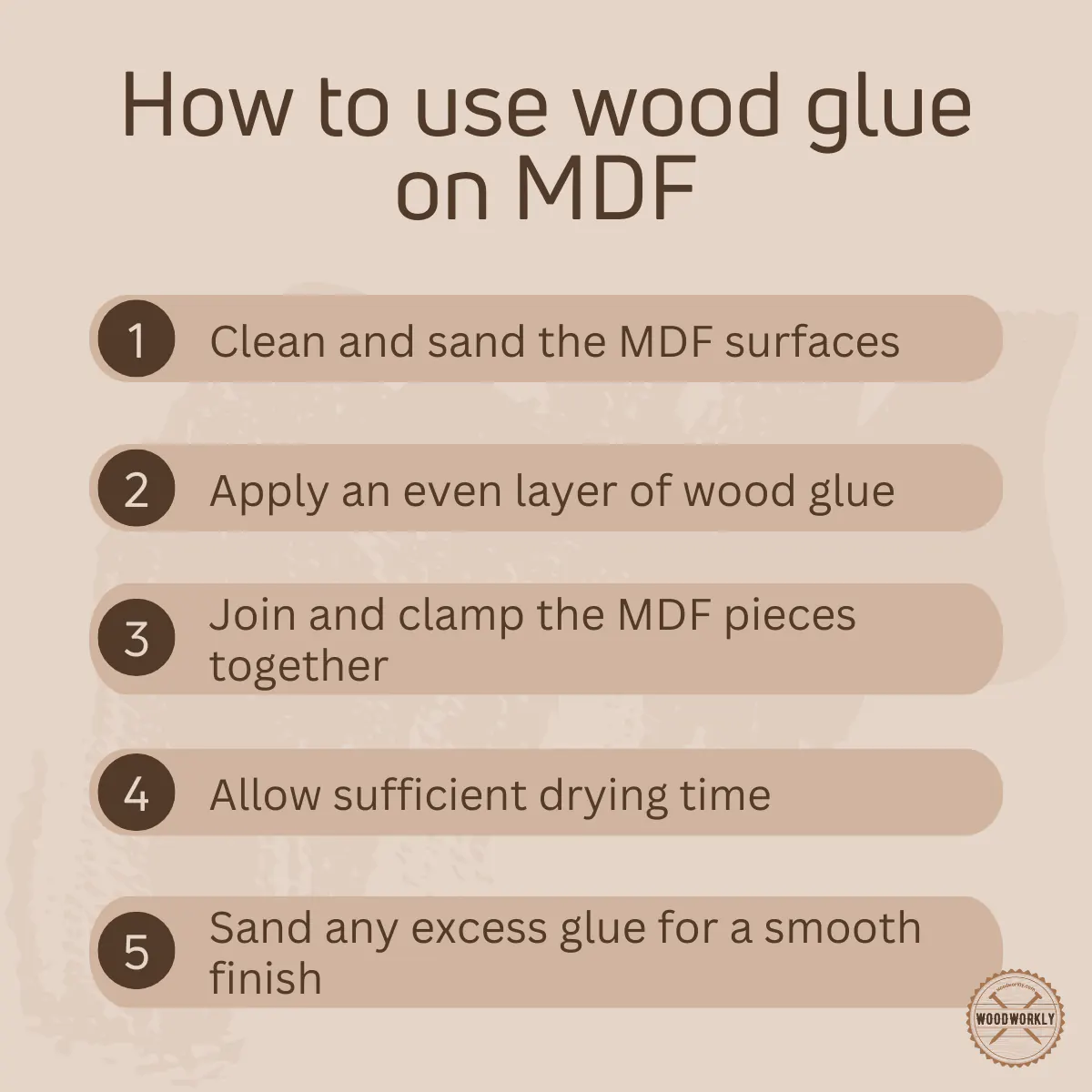
Congrats folks! Now you know whether does wood glue work on MDF with the application steps.
So, let’s answer some frequently asked questions.
FAQs
Can I use regular wood glue for MDF?
Yes, Many regular wood glues, especially PVA (Polyvinyl Acetate) types, bond MDF quite effectively. Just ensure you prep your surfaces right, and you’re good to go.
Does MDF absorb glue faster than regular wood?
Yes, MDF absorbs glue faster than regular wood due to its porous nature, MDF can absorb glue more quickly. Always apply a thin, even layer to prevent unnecessary swelling or warping of the board.
Will the glue hold MDF permanently?
When applied correctly, quality wood glues can create a durable bond with MDF. Remember, proper surface prep and clamp usage are crucial for longevity.
Is there a risk of MDF swelling with glue application?
Yes, MDF can swell if too much glue is applied or if water-based glue saturates the board. Hence, a thin, even spread of glue is recommended.
Do I need to sand MDF before gluing?
Lightly sanding MDF edges before gluing can enhance the bond. Think of it as creating little grooves for the glue to grip onto.
How long should I clamp MDF after gluing?
It’s best to follow the glue manufacturer’s guidelines, but generally, a few hours to overnight ensures a solid bond. As I always say, patience is a virtue!
Do I need special clamps for MDF?
No special clamps are required, but ensuring even pressure along the glued edges will yield the best results. Trust me, your standard clamps will do the trick!
Can I glue MDF to other materials?
Certainly! MDF can be glued to other woods or materials. Just ensure both surfaces are clean, and pick a glue suitable for multi-material bonding.
Can humidity affect the glue bond on MDF?
Yes, high humidity can weaken the bond over time, especially if a non-water-resistant glue was used. Always consider your project’s environment and choose your glue wisely!
Did I cover all you wanted to know about: Does Wood Glue Work on MDF?
In this article, I’ve deeply discussed how does wood glue work on MDF, what are the best types of MDF glues, the best commercially available wood glue for MDF board with their applications, pros, and cons. Also, how to stick pieces of MDF together as well.
Wood glue work on MDF. But you need to consider whether it’s face-to-face gluing or edge gluing. Even though most glues bond with MDF, you need to select the best wood glue according to the location. Edge gluing of MDF can be tricky and you need to use special types of wood glues other than regular ones due to end grain.
At the end of the day, my advice as a long-time woodworker is, whenever you’re going for wood glue for the MDF board, select the one according to your application type.
Not every glue does the same task.
Also, if you want to apply wood glue to the MDF board, I highly suggest you do your best to practice it with a small piece of MDF without directly going for your main woodwork, then you can get it. Clear idea about the glue strength, its color, and how matching it is.
According to the things you’ve learned give it a go and make your MDF joints with wood glue.
Hope this article will help you to face any circumstances without any issues with proper guidance.
So glad I found your site !
I’m repurposing my laminated MDF study table into a desk wall (dunno if that’s the term for it) to eliminate distractions as I currently work from home in my room haha . . I wanted to know how things work exactly
Learned a lot, sir ~
Thank you so much ! from the PH :]